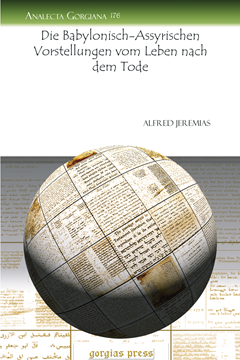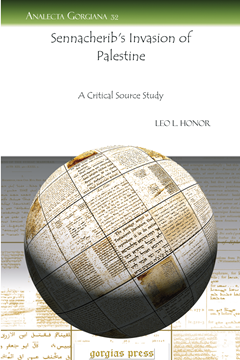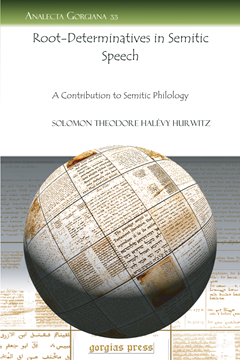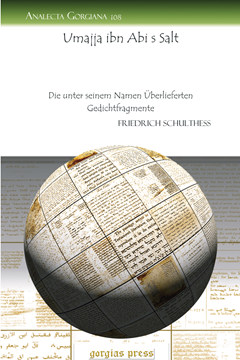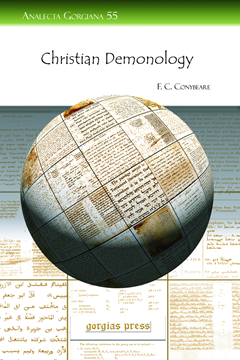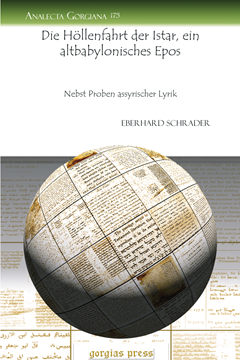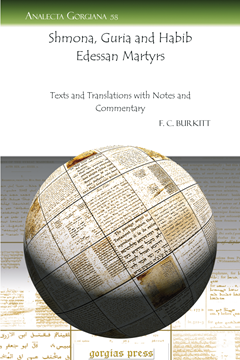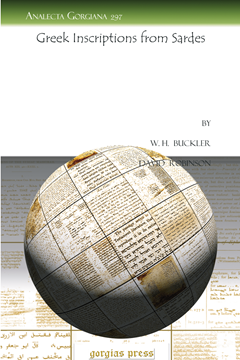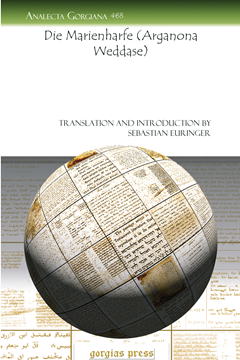Analecta Gorgiana
Analecta Gorgiana is a collection of long essays and short monographs which are consistently cited by modern scholars but previously difficult to find because of their original appearance in obscure publications. Carefully selected by a team of scholars based on their relevance to modern scholarship, these essays can now be fully utilized by scholars and proudly owned by libraries.
Die Babylonisch-Assyrischen Vorstellungen vom Leben nach dem Tode
Series: Analecta Gorgiana 176
ISBN: 978-1-60724-247-5
In this brief study, Jeremias examines the representations of life after death in the Babylonian and Assyrian sources. The descent of Ishtar, basic concepts of the grave, descriptions of the afterlife and the realm of the blessed are all examined. The possibility of return from death and the biblical outlook on the subject are also part of the exploration.
$61.00 (USD) $36.60 (USD)
The Armenian Rite
Series: Analecta Gorgiana 135
ISBN: 978-1-60724-098-3
In his classic introduction to Armenian Orthodox liturgies, King examines the liturgies of the Oriental Orthodox churches. In this volume the Ethiopic rite is considered. The rite is described and given a context in the setting of its native church.
$61.00 (USD) $36.60 (USD)
Muslim Law of Marriage and Divorce
By Ahmed Shukri
Series: Analecta Gorgiana 31
ISBN: 978-1-59333-625-7
Concerned that many in his day did not understand basic Muslim teaching led Shukri to produce this brief monograph. In it he explores the various schools of Islamic jurisprudence and the teachings concerning the legal issues of marriage and divorce, including the topic of the equalities of the partners.
$61.00 (USD) $36.60 (USD)
Sennacherib's Invasion of Palestine
A Critical Source Study
By Leo L. Honor
Series: Analecta Gorgiana 32
ISBN: 978-1-59333-626-4
Considering both the Assyrian and biblical sources for the description of Sennacherib’s devastating invasion on Palestine, Honor tests the records to see if he can develop an historical account. He makes use of the Annals of Sennacherib and the biblical books of 2 Kings, 2 Chronicle, and Isaiah.
$62.00 (USD) $37.20 (USD)
Root-Determinatives in Semitic Speech
A Contribution to Semitic Philology
Series: Analecta Gorgiana 33
ISBN: 978-1-59333-627-1
Suggesting that the Semitic root may be, at least subconsciously, biliteral, Hurwitz launches into a study of this phenomenon. Discussing linguistic phenomena such as pluriliteral forms, root-differentiation, and folk-etymologies, this little study covers significant ground for understanding the underlying structure of biblical Hebrew.
$62.00 (USD) $37.20 (USD)
Style and Language in the Writings of Saint Cyprian
By E. W. Watson
Series: Analecta Gorgiana 13
ISBN: 1-59333-491-5
A thorough analysis of St. Cyprian’s writing style and use of language, this study is invaluable for the student of the saint. Comparison with contemporary writers and careful attention to grammatical and linguistic elements mark this useful study of an important figure of early Christianity.
$63.00 (USD) $37.80 (USD)
Umajja ibn Abi s Salt
Die unter seinem Namen Überlieferten Gedichtfragmente
Series: Analecta Gorgiana 108
ISBN: 978-1-60724-034-1
In this collection of poetry of Umayya ibn Abi al-Salt, as well as poems published in his name, Schulthess does a great service in bringing together these legendary Arabic poems. Umayya ibn Abi al-Salt was a contemporary of Muhammad who did not accept Islam. Printed here in the original Arabic, the poems are also translated in German and annotated. Schulthess also provides a knowledgeable introduction that includes a listing of the manuscript sources utilized in the reconstruction of the texts.
$63.00 (USD) $37.80 (USD)
Christian Demonology
Series: Analecta Gorgiana 55
ISBN: 978-1-59333-870-1
This work is concerned primarily with the treatment of the demonic within early Christian literature, but also incorporates evidence from various other world religions, especially early Judaism and paganism.
$64.00 (USD) $38.40 (USD)
A Western Awakening to Islam
By Lord Headley
Series: Analecta Gorgiana 189
ISBN: 978-1-60724-285-7
Wishing to educate the western world to the wonders of Islam, Lord Headley penned several books on the religion. In the present volume he volunteers the various attributes that made Islam a viable option for a western citizen. Understanding the religion would ultimately undermine fears others felt toward the unfamiliar faith. Taking traditional areas of concern to task, he addresses peacefulness, women’s place in Islam, willful misrepresentations, self-control, fear, law and order, converts, praise and thanksgiving, and the continuation of God’s blessings. Such a strong case suggested to his readers that society’s fears stemmed from misunderstanding.
$65.00 (USD) $39.00 (USD)
The Syrian Rite of Antioch
Series: Analecta Gorgiana 130
ISBN: 978-1-60724-094-5
In his classic introduction to Eastern Orthodox liturgies, King examines the liturgies of the Oriental Orthodox churches. In this volume the Syrian rite is considered. The rite is described and given a context in the setting of its native church.
$66.00 (USD) $39.60 (USD)
The New Revision of King James' Revision of the New Testament.
Series: Analecta Gorgiana 308
ISBN: 978-1-60724-540-7
Charles Short gives a clear and thorough overview of the history of the English Bible and its relation to the changing editions of the Greek and Hebrew texts, then gives a detailed analysis of the revised text of Matthew.
$67.00 (USD) $40.20 (USD)
Die Höllenfahrt der Istar, ein altbabylonisches Epos
Nebst Proben assyrischer Lyrik
Series: Analecta Gorgiana 175
ISBN: 978-1-60724-246-8
This volume contains Schrader’s study of the underworld journey of Ishtar. He examines this Old Babylonian epic together with samples from Assyrian poems. The text is given, along with a translation, commentary and glossary.
$68.00 (USD) $40.80 (USD)
The Coptic Rite
Series: Analecta Gorgiana 132
ISBN: 978-1-60724-096-9
In his classic introduction to Eastern Orthodox liturgies, King examines the liturgies of the Oriental Orthodox churches. In this volume the Coptic rite is considered. The rite is described and given a context in the setting of its native church.
$69.00 (USD) $41.40 (USD)
The Ethiopic Rite
Series: Analecta Gorgiana 134
ISBN: 978-1-60724-097-6
In his classic introduction to Eastern Orthodox liturgies, King examines the liturgies of the Oriental Orthodox churches. In this volume the Ethiopic rite is considered. The rite is described and given a context in the setting of its native church.
$69.00 (USD) $41.40 (USD)
The Chaldean Rite
Series: Analecta Gorgiana 137
ISBN: 978-1-60724-101-0
In his classic introduction to Byzantine Orthodox liturgies, King examines the liturgies of the Oriental Orthodox churches. In this volume the Chaldean rite is considered. The rite is described and given a context in the setting of its native church.
$70.00 (USD) $42.00 (USD)
The Medieval Legend of Judas Iscariot
Its History and Diffusion
Series: Analecta Gorgiana 73
ISBN: 978-1-59333-888-6
Professor Baum provides the reader with an in depth study of the Life of Judas the Betrayer, which obviously mirrors the story of Oedipus, and its various recensions, as well as a study of the English ballad of Judas Iscariot.
$70.00 (USD) $42.00 (USD)
The Songs of the Return (Psalms 120-134)
A Critical Commentary with Historical Introduction, Translation and Indexes
Series: Analecta Gorgiana 76
ISBN: 978-1-59333-890-9
Appended to this thesis is a short work, which stood in place of a proposed work on the precise topic of Stevens’ thesis. The shorter piece, by Professor Paul Haupt focuses specifically on Psalm 130.
$70.00 (USD) $42.00 (USD)
Social Aspects of Christianity
Series: Analecta Gorgiana 199
ISBN: 978-1-60724-301-4
In this influential book, Ely produced an impact outside his own field of economy that was felt in the world of theological study. Still timely and sensible, this treatment of a layman’s view of the social obligations of Christianity maintains its ability to challenge convention and urge for progress. A significant treatment of an essential aspect of ethical religious principles, this book would be profitably read by all who are interested in a fair society.
$70.00 (USD) $42.00 (USD)
Shmona, Guria and Habib Edessan Martyrs
Texts and Translations with Notes and Commentary
Series: Analecta Gorgiana 58
ISBN: 978-1-59333-873-2
In this book the Syriac texts along with translations of the tales of the martyrs are introduced by Professor Burkitt with a commentary focusing on the historicity of the different accounts.
$71.00 (USD) $42.60 (USD)
Untersuchungen zur syrischen Überlieferung der Siebenschläferlegende und Die älteste Gestalt der Sie
Edited and Translated by Arthur Allgeier
Series: Analecta Gorgiana 440
ISBN: 978-1-60724-777-7
Arthur Allgeier publishes here two articles concerning the “Legend of the Seven Sleepers” in the Syriac tradition. The first article includes a discussion of the text’s transmission history and the second includes the Syriac text, German translation, and apparatus.
$72.00 (USD) $43.20 (USD)
Zur Historischen Topographie von Persien
Series: Analecta Gorgiana 80
ISBN: 978-1-59333-855-8
Originally a two-part publication, geographer Wilhelm Tomaschek’s study on the historic topography of Persia is here published in one volume. Beginning with the street layout of the Tabula Peutingerana, the author describes the major routes of the Persian realm as reflected in antiquity. Although reflecting the period of the Qajar Dynasty prior to the developments during the World Wars, this guide still provides historic information concerning the mapping of one of the great empires of the ancient world.
$73.00 (USD) $43.80 (USD)
Mémoire sur la Conquête de la Syrie
Series: Analecta Gorgiana 91
ISBN: 978-1-60724-010-5
Taken from the collection of studies published under the collective title Mémoires de l'histoire et de Ia geographie orientales, Mémoire sur la Conquête de la Syrie stands as a monument to the insight of M. J. de Goeje on the Arabic conquest of Syria. This brief account of an important phase of Syria’s history will be sure to please those interested in the general history of the Middle East as well as scholars studying the rise of Islam.
$73.00 (USD) $43.80 (USD)
The Haft Ásmán or History of the Masnawí of the Persians
Series: Analecta Gorgiana 118
ISBN: 978-1-60724-052-5
Presented in the original Persian, this volume represents the solely published first volume of the Haft Ásmán “seven heavens,” or a compendium of poetry in the seven epic meters of Persian poetry. This history of the masnawí, or Middle Persian poetic form, written in rhymed couplets, is here presented by one of the recognized teachers of Persian in India. This, his final work, was intended to be an introduction to the works of Nizami. As such it contains invaluable nuggets about the Persian poets and their poetry.
$74.00 (USD) $44.40 (USD)
Greek Inscriptions from Sardes
Series: Analecta Gorgiana 297
ISBN: 978-1-60724-526-1
This piece includes the text, translation, and commentary for a long inscription found on the temple of Artemis and shorter honorific inscriptions on cylindrical stelai found in the ancient city, all dating from the 4th century BC.
$77.00 (USD) $46.20 (USD)
Die Marienharfe (Arganona Weddase)
Translation and Introduction by Sebastian Euringer
Series: Analecta Gorgiana 468
ISBN: 978-1-60724-923-8
Sebastian Euringer publishes here a German translation of the Ethiopic text of a grand poem dedicated to the Virgin Mary from the “monophysite” tradition. Euringer accompanies the translation with an introduction and critical notes.
$77.00 (USD) $46.20 (USD)

